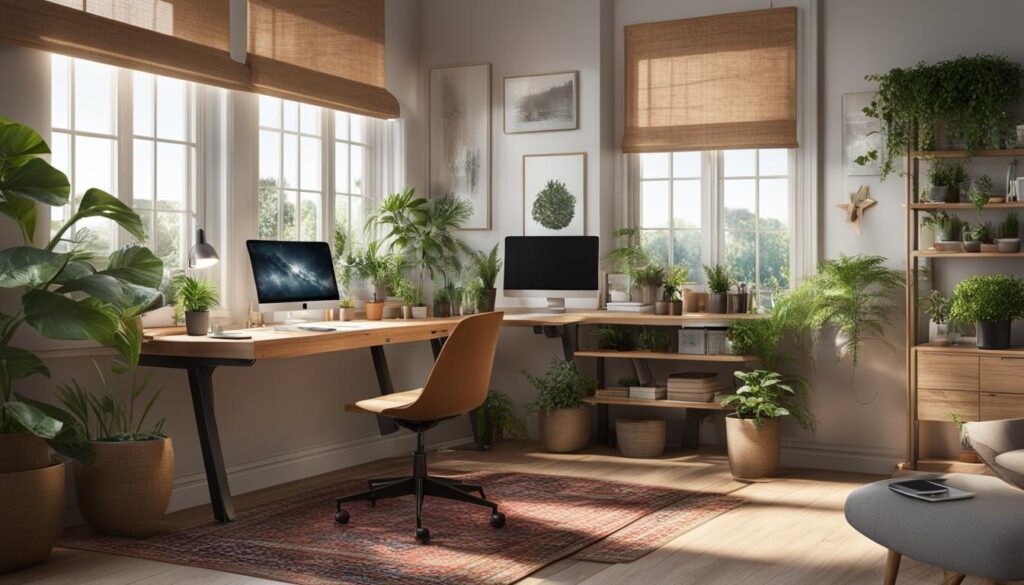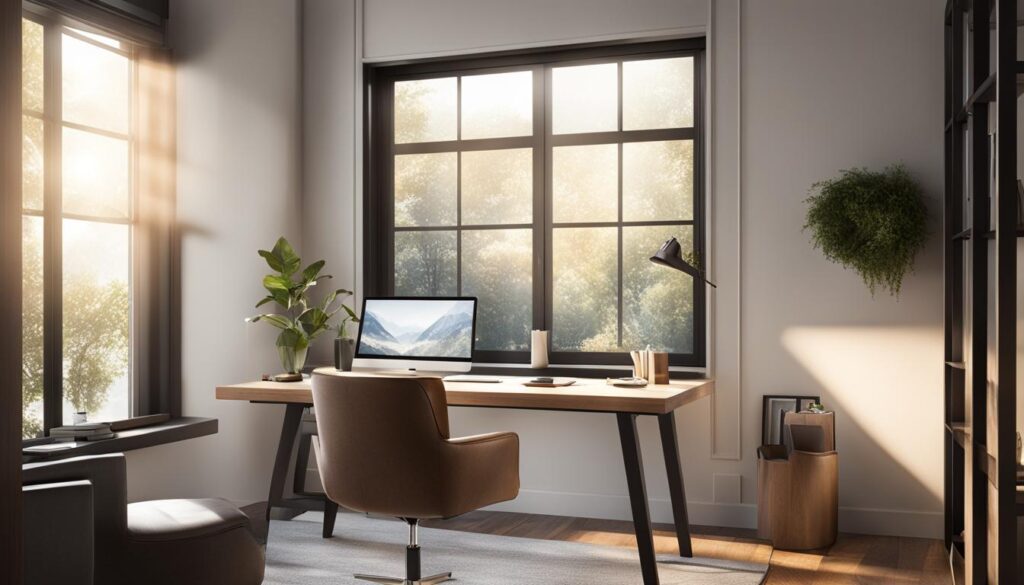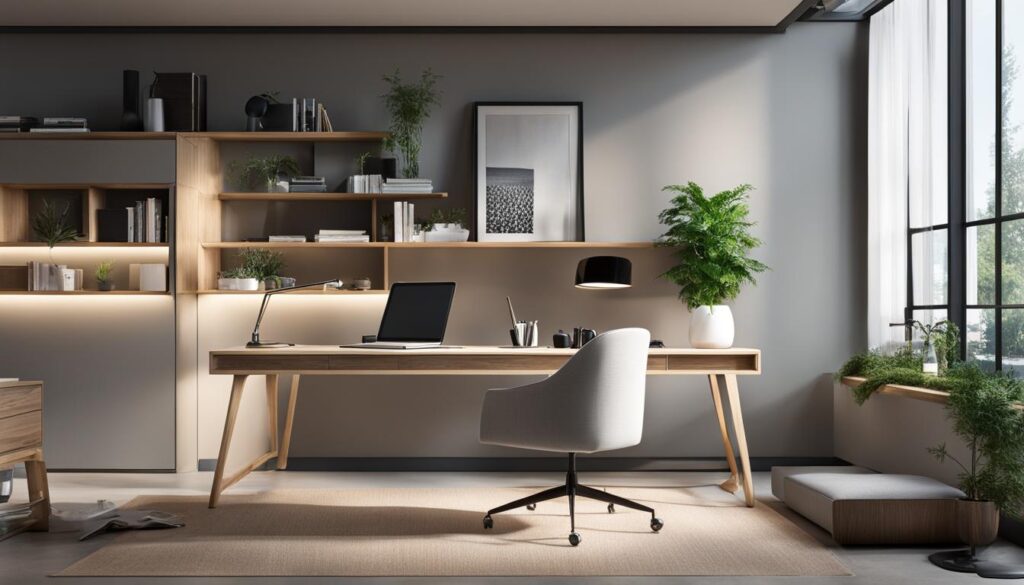A dedicated work space in your home helps you set aside household distractions and focus on work. Whether you have a small corner of a room or a dedicated home office, designing your workspace to maximize productivity and style is important. In this article, we will explore various design ideas and tips sourced from reputable interiors websites to help you create a home office that inspires creativity, minimizes distractions, and enhances your overall productivity and style.
Post Summary
- Designing a separate workspace can help create a mental distinction between work and relaxation areas.
- Optimizing lighting, including natural light and task lighting, can significantly improve productivity.
- Minimizing distractions through soundproofing and ergonomic design is essential.
- Adding personal touches like color accents and indoor plants can enhance the aesthetic appeal of your home office.
- Prioritizing comfort, organization, and aesthetics will create an inspiring and efficient workspace.
Designing a home office that boosts productivity and style is essential for creating an inspiring and efficient workspace. By separating your workspace from your living area, optimizing lighting, controlling distractions, and adding personalized touches, you can create a home office that inspires creativity and enhances your overall productivity. Remember to prioritize comfort, organization, and aesthetics when designing your home office. With the right design elements, your home office can become a haven of productivity and style.
Designing a Separate Workspace
To create a productive home office, it’s crucial to separate it from your living space. Identify a corner of a room or a spare room where you can set up your workspace. If you have the luxury of a separate room, convert it into a dedicated home office. For limited spaces, consider using a table and chair that are solely designated for work. By creating a physical distinction between your work area and relaxation space, you can mentally transition into a focused work mindset when you enter your home office.
Consider the following tips when designing a separate workspace:
- Choose a location with minimal distractions, away from high-traffic areas of your home.
- Utilize room dividers or curtains to visually separate your home office from the rest of the room.
- Invest in a comfortable chair and ergonomic desk to ensure proper posture and reduce the risk of back pain.
- Declutter and organize your workspace regularly to maintain a clean and efficient environment.
Remember, a separate workspace is essential for creating a dedicated and focused environment, helping you maximize productivity and efficiency in your home office.
Designing a Separate Workspace – Tips from Experts
“When designing a separate workspace, it’s important to choose a location that provides privacy and limits interruptions. This will help you maintain focus and productivity throughout the day.” – Interior Design Magazine
| Advantages of a Separate Workspace | Disadvantages of a Shared Workspace |
|---|---|
|
|
Lighting for Productivity
When designing your home office, one important factor to consider is lighting. Proper lighting can significantly impact your productivity and overall work experience. There are several aspects of lighting to take into account to create an optimal environment for work.
1. Natural Light
Utilizing natural light can have numerous benefits for your productivity. Whenever possible, position your home office near a window to maximize exposure to natural light throughout the day. Natural light not only boosts your mood and mental well-being but also helps in maintaining focus and reducing eye strain. If your workspace is lacking in natural light, consider installing a skylight or using mirrors strategically to reflect and enhance the natural light.
2. Circadian Lighting
Circadian lighting is an innovative lighting system that mimics the natural daylight cycle. It adjusts the color and intensity of the light throughout the day, replicating the effects of natural sunlight. This type of lighting can help regulate your body’s sleep-wake cycle, keeping you energized and focused during work hours. Investing in circadian lighting for your home office can have a positive impact on your productivity and overall well-being.
3. Task Lighting
In addition to natural and circadian lighting, it’s essential to have task lighting in your home office. Task lighting provides focused illumination for specific work-related tasks, such as reading documents or working on your computer. Consider adding desk lamps or adjustable task lights to ensure proper lighting for your workspace. Adjustable task lights allow you to control the direction and intensity of the light, providing flexibility based on your needs.
Enhancing your home office’s lighting can significantly improve your productivity and overall work experience. By incorporating natural light, circadian lighting, and task lighting, you can create a well-lit workspace that promotes focus, reduces eye strain, and enhances your mood. Remember to position your workspace near a window, consider circadian lighting options, and incorporate task lighting for optimal lighting conditions.
Comparison of Lighting Options
| Lighting Option | Benefits | Considerations |
|---|---|---|
| Natural Light |
|
|
| Circadian Lighting |
|
|
| Task Lighting |
|
|
Creating a Productive Environment
When designing your home office, it’s crucial to consider the factors that can distract you from your work and find ways to minimize them. By creating a productive environment, you can optimize your focus and efficiency. One of the main distractions in a home office is noise. Whether it’s the sounds of children playing, neighbors’ conversations, or street noise, these interruptions can significantly impact your concentration.
To control noise distractions, consider soundproofing your home office. You can use materials like heavy curtains, acoustic panels, or even install soundproof windows to reduce outside noise. Another effective solution is using noise-canceling headphones. These headphones actively block out external noises, allowing you to work in peace and silence. By controlling noise, you can create a quieter and more conducive workspace.
Another important aspect of a productive environment is ergonomic design. A well-designed home office should prioritize your comfort and physical well-being. Invest in a high-quality office chair that provides proper lumbar support and allows for adjustable height and backrest positions. An ergonomic chair promotes good posture and reduces the risk of back pain or discomfort during long work hours. Additionally, choose a desk that suits your needs and preferences. Consider factors such as height adjustability, sufficient space for your equipment, and a layout that promotes efficient workflow.
Keeping your workspace clean and organized is also essential for creating a productive environment. Clutter and disorganization can lead to distractions and decrease your efficiency. Ensure that everything you need for your work is within easy reach, so you don’t have to interrupt your workflow searching for essential items. Use storage solutions such as drawers, shelves, or filing cabinets to keep your documents, supplies, and equipment neatly organized. A clean and organized workspace will help you maintain focus and productivity throughout the day.
“A productive environment minimizes distractions and enhances focus and efficiency.”
Comparison of Home Office Distractions and Solutions
| Distraction | Solution |
|---|---|
| Noise | Soundproofing materials, noise-canceling headphones |
| Discomfort | Ergonomic chair, adjustable desk |
| Disorganization | Storage solutions, maintaining a clean workspace |
Personal Touches
To make your home office truly reflect your personality, incorporate personal touches that inspire and motivate you. Display inspirational quotes or images that resonate with you and provide a sense of purpose and motivation. Consider creating a vision board or gallery wall to showcase your aspirations and goals. These personal touches will not only make your home office feel more inviting and unique but also serve as constant reminders of what you’re striving for.
| Benefits of Adding Style and Personality to Your Home Office |
|---|
| Creates an inspiring and visually appealing workspace |
| Infuses energy and creativity into your home office |
| Improves air quality and creates a calming atmosphere with indoor plants |
| Adds a touch of whimsy and coziness through decorative lighting |
| Personal touches provide motivation and inspiration |
Conclusion
Congratulations on taking the initiative to design a home office that boosts productivity and style! By following the tips and ideas we’ve discussed, you can create a workspace that inspires creativity, minimizes distractions, and enhances your overall work output.
Remember, it’s crucial to separate your home office from your living space. Creating a physical distinction between work and relaxation areas allows you to mentally transition into a focused work mindset when you enter your workspace.
Optimizing lighting is another key factor in productivity. Make the most of natural light by positioning your home office near a window or consider installing a skylight. Supplement with task lighting and add a touch of creativity with color-changing accent lights.
To create a productive environment, minimize distractions and invest in ergonomic furniture that promotes comfort and efficiency. Keep your workspace organized and add personal touches like a pop of color through desk accessories or indoor plants to make it a visually appealing and inspirational space.
With the right design elements, your home office can become a haven of productivity and style. Take the time to prioritize comfort, organization, and aesthetics, and enjoy the benefits of a well-designed workspace in your own home.
FAQ
How do I create a separate home office workspace?
Identify a corner of a room or a spare room where you can set up your workspace. If you have limited space, consider using a designated table and chair solely for work.
What role does lighting play in a home office?
Lighting is crucial for productivity. Position your home office near a window to maximize natural light or invest in circadian lighting that mimics natural daylight. Supplement with task lighting and accent lights for a touch of creativity.
How can I minimize distractions in my home office?
Consider soundproofing your office or using noise-canceling headphones. Invest in an ergonomic office chair for comfort and efficiency. Keep your workspace clean and organized to avoid interruptions.
How can I add style to my home office?
Add a pop of color with desk accessories or vibrant artwork. Incorporate indoor plants for a touch of nature and improved air quality. Experiment with decor elements like string lights or tapestries.
How can I design a home office that boosts productivity and style?
Separate your workspace from your living area, optimize lighting, control distractions, and add personalized touches. Prioritize comfort, organization, and aesthetics to create an inspiring and efficient workspace.












